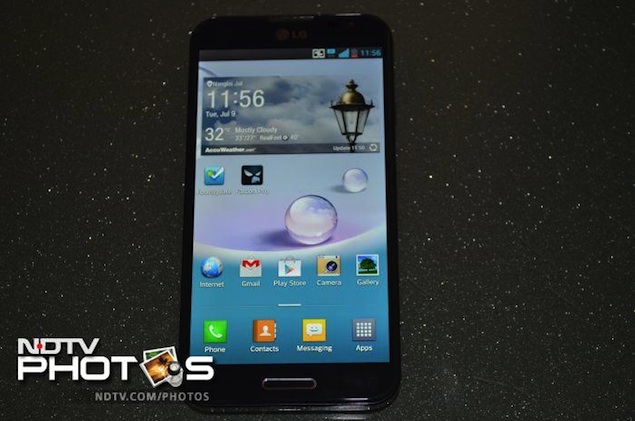
Almost five months after launching the phone globally, LG has finally brought the Optimus G Pro to the Indian shores. Successor to the LG Optimus G, the phone is not just an incremental upgrade and brings with it a new design, a large 5.5-inch screen and upgraded hardware.
While there are a number of phones that feature 5.5-inch or plus screens, the Optimus G Pro is among the first to feature a full-HD display. We try to find out if the phone meets all the expectations.
Build/ Design
With a 5.5-inch screen, the LG Optimus G Pro enters the phablet territory. However, when compared to a phone like the Samsung Galaxy Note II, it looks and feels more like a big smartphone, predominantly due to its less wider frame. Still, it's not a phone that would fit comfortably in your pocket. The phone is available in White and Black colour variants and we received the Black one as our review unit.
The front of the phone, made of glass, is mainly dominated by its 5.5-inch HD display. The bezel on the sides of the screen is extremely narrow, though if you notice carefully it still has a small black border surrounding it. The front glass doesn't meet the edges directly but curves and bevels before it reaches there.
There's a physical Home button and two capacitive touch buttons for Back and Menu functions just below the display. The Home button does't protrude out much, unlike Samsung's Galaxy S4 and Note II phones, and is almost flush with the phone. We had a hard time using the button as it's too small in height. It does light up in different colours to alert you whenever there's a notification, though.
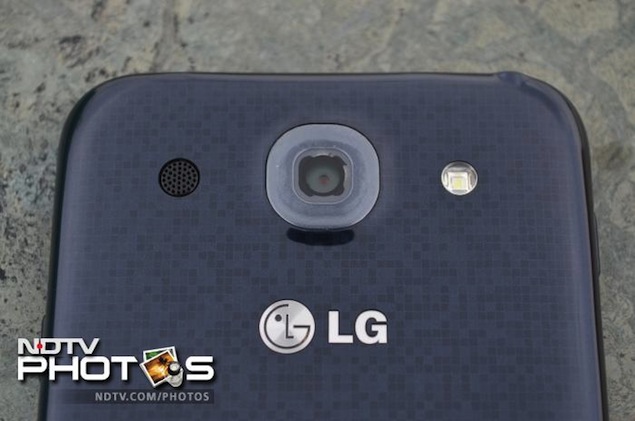 The 2.1-megapixel front facing camera and the sensor array sit a hove the display along with an earpiece grill.
The 2.1-megapixel front facing camera and the sensor array sit a hove the display along with an earpiece grill.
The Power/ Screen-lock button is located at the right hand side of the phone, while a customisable 'Quick' key and the Volume rocker key are placed at the left hand side. We found the placement of the keys a bit awkward. For a phone this big, we wish the Power button could have been placed a little lower. Also, we ended up pressing the Quick shortcut button instead of the Volume rocker on several occasions.
The 3.5mm headset jack, Infrared Blaster and a secondary microphone sit at the top. The Micro-USB port and the microphone are located at the bottom.
An aluminium frame runs through the phone separating the back and front panels. The frame is visible as a thin line at the left and right sides, but widens at the top and bottom.
Unlike the LG Optimus G, the Optimus G Pro has a removable back panel which covers the back of the phone and is not boxy, but curved along the edges. Made of plastic, it can be easily removed through a small gap at the right side of the phone. The back has a glossy finish but features a glass weave checkered pattern similar to the one seen in the Nexus 4. However, the cover is prone to smudges and is a little slippery and doesn't provide a good grip.
The 13-megapixel camera lens, the LED flash and a tiny round speaker outlet are located towards the upper part of the back. The lens is surrounded by a raised, almost circular, enclosure which is also visible.
 Removing the back cover, you'd see the battery compartment, with the Micro-SIM and microSD card slots located just below it. While you can replace the microSD card on the fly, you'll need to remove the battery if you want to insert or remove the Micro-SIM.
Removing the back cover, you'd see the battery compartment, with the Micro-SIM and microSD card slots located just below it. While you can replace the microSD card on the fly, you'll need to remove the battery if you want to insert or remove the Micro-SIM.
Overall, the phone feels solid without giving an impression of being bulky but we wish it could offer a better grip, especially when it's as big as it is.
Display
The LG Optimus G Pro features a 5.5-inch IPS Plus LCD screen with a resolution of 1080x1920 pixels. It is one of the few full-HD 5.5-inch phones available in the market (the other one being Lenovo K900), at this point in time. It comes with Corning 's Gorilla Glass 2 protection making it resistant to scratches.
 The Optimus G pro's screen looks gorgeous with text and images looking crisp and sharp. Colours look vibrant and brightness was optimum. Viewing angles were also good, though we found the screen to be pretty reflective especially when used outdoors in bright sunlight. Having said that, we didn't experience problems reading text under sunlight.
The Optimus G pro's screen looks gorgeous with text and images looking crisp and sharp. Colours look vibrant and brightness was optimum. Viewing angles were also good, though we found the screen to be pretty reflective especially when used outdoors in bright sunlight. Having said that, we didn't experience problems reading text under sunlight.
Since the phone's screen is large, the pixel density is a little less compared to phones like the HTC One or the Samsung Galaxy S4, even though the Optimus G Pro has a full-HD display. This means there are less pixels per inch but you are unlikely to notice the difference.
Software/ User Interface
The LG Optimus G Pro runs Android 4.1.2 Jelly Bean, which is a disappointment as even some budget phones are now shipping with Android 4.2. LG has added its own Optimus UI layer on top, majorly changing the look and feel of the interface and enabling users to customise the phone according to their liking.
LG also adds several tweaks including Smart Screen that keeps the screen on if the phone detects the user's eyes looking at it - a feature we first saw in the Samsung Galaxy S III. It also adds Smart Video, automatically pausing videos when you look away.
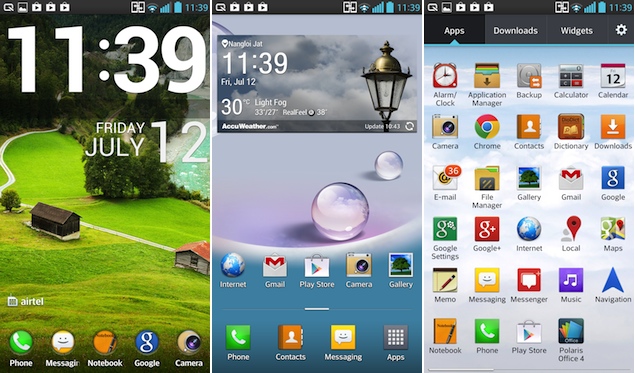 LG also allows users to choose the phone's default font and font size, change how long the capacitive keys backlight stays on, choose the LED light on the Home button to glow with different alerts and correct the aspect ratio of downloaded apps.
LG also allows users to choose the phone's default font and font size, change how long the capacitive keys backlight stays on, choose the LED light on the Home button to glow with different alerts and correct the aspect ratio of downloaded apps.
You can select from 4 different visual themes, each with a different icon set, home screen wallpaper and app drawer background. You can have up to 7 screens that can be populated with widgets and app shortcuts. LG even allows you to choose between various animation effects when you swipe from one home screen to another or when you unlock the phone.
We're glad that LG has placed the Back button on the left side in line with the Nexus phones. The Home button doubles up as the task switcher on long press. The contextual Menu button offers various settings when pressed in the home screen mode.
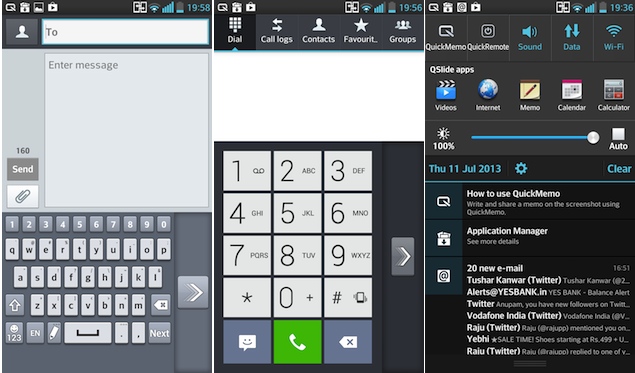 LG has also skinned the notification tray including toggles for various settings including for sound, data, NFC, Quick remote, Bluetooth, Wi-Fi, and Hotspot among others. It also features shortcuts for invoking QSlide apps, and a control for changing screen brightness.
LG has also skinned the notification tray including toggles for various settings including for sound, data, NFC, Quick remote, Bluetooth, Wi-Fi, and Hotspot among others. It also features shortcuts for invoking QSlide apps, and a control for changing screen brightness.
As we mentioned, the phone comes with a 5.5-inch display, and LG has included some additional features to make use of the screen real estate. There are special apps that LG likes to call QSlide apps. These include a web browser, Memo pad, Calendar, Calculator and a Video player. Users can run two of these QSlide apps simultaneously and there's a slider that allows you to focus on one of them. This is similar to what Samsung introduced with some of its devices including the Galaxy Note II.
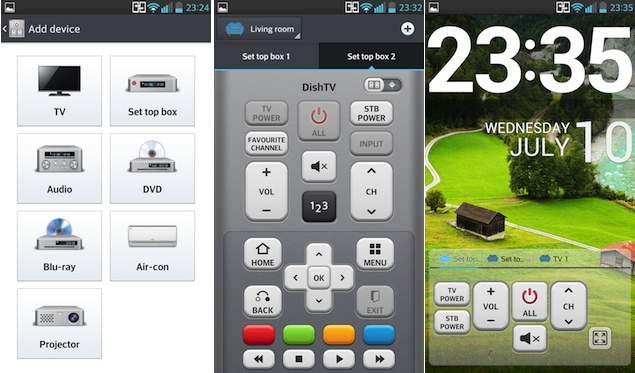 LG also offers a QuickMemo app that lets users scribble notes on a blank page or on top of a screen shot. The app also has an overlay mode allowing you to take notes while running another app. We're not sure if people with big hands will find it useful as LG doesn't offer a Stylus with the phone.
LG also offers a QuickMemo app that lets users scribble notes on a blank page or on top of a screen shot. The app also has an overlay mode allowing you to take notes while running another app. We're not sure if people with big hands will find it useful as LG doesn't offer a Stylus with the phone.
The phone includes additional ones for Backup, File Manager, File sharing, a Dictionary, a Memo app, a Notebook app, Polaris Office 4, a Quick Translator app, LG's service related apps, LG's own app store (SmartWorld), a Task Manager, and apps for video editing. The phone also allows streaming content to other devices via the DLNA protocol in addition to offering wireless screen mirroring via Miracast to compatible devices.
LG has customised nearly all stock-apps including the Gallery and Music apps, adding more functionality in addition to just bringing eye candy. Even the system settings menus have been skinned and are pleasant to look at.
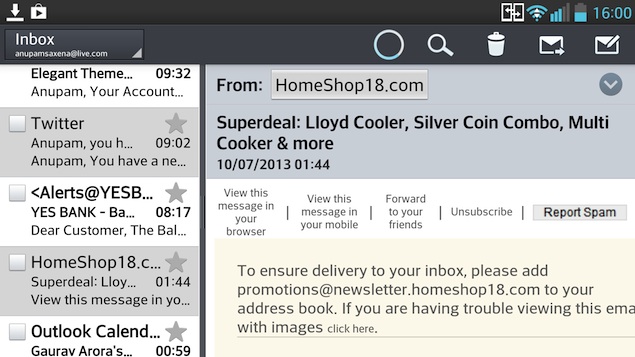
The home screen also features a landscape mode, and some of the apps, including LG's email app make use of it by offering a preview pane for emails in that mode.
The Music player app, offers additional functionality of giving you access to your music library within the Now Playing screen in landscape mode. It can also display lyrics if embedded in the track and look for the video of the currently playing song on YouTube with the press of a button. It also offers Dolby sound enhancements when headphones are connected to the phone.
Similarly, the Video Player offers a drawer on the right side for browsing videos while playing one. It also allows you to change the brightness by just swiping across the screen vertically, and scrub through it by swiping horizontally. The Video player app can run simultaneously with other apps similar to Samsung's pop-up play feature. The video player also comes with its own QSlide app. Pinch to zoom even works while playing videos to see more details.
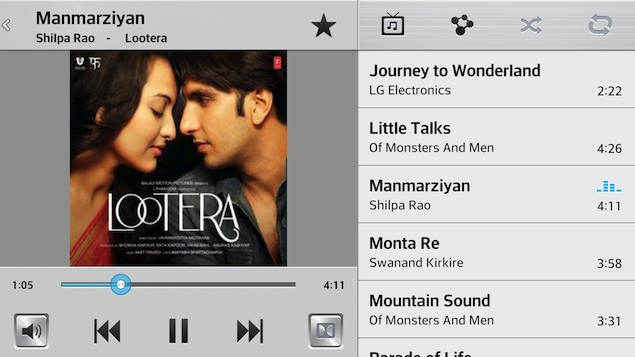 The LG Optimus G Pro also offers a Quick Remote app to be used in conjunction with the phone's Infrared Blaster. It allows the phone to act as a universal remote to control audio, video and home appliances. It even offers remote controls for Indian satellite TV providers such as Tata Sky and Dish TV. We were able to easily configure the app and use the phone as our remote. Interestingly, the app can also be used without unlocking the phone's home screen by long pressing the Home button. It can also be used through a quick shortcut in the notifications panel through a dedicated toggle.
The LG Optimus G Pro also offers a Quick Remote app to be used in conjunction with the phone's Infrared Blaster. It allows the phone to act as a universal remote to control audio, video and home appliances. It even offers remote controls for Indian satellite TV providers such as Tata Sky and Dish TV. We were able to easily configure the app and use the phone as our remote. Interestingly, the app can also be used without unlocking the phone's home screen by long pressing the Home button. It can also be used through a quick shortcut in the notifications panel through a dedicated toggle.
LG has also included software features to enable one hand operation. You can set the phone's default keyboard and keypad to be displayed towards the right or left sides.
In addition to all of these, the phone brings standard Jelly Bean functionality. Overall, LG has tried to make the phone as different from stock Android, as possible. While that may delight some, 'stock-Android' fans will be far from impressed.
Camera
The LG Optimus G Pro sports a 13-megapixel rear camera and a 1.9-megapixel front facing camera. We expected it to be a great shooter given the phone's price and high end specifications, but does it deliver?
For starters, the phone features LG's own Camera app which is a bit similar to the app that comes with the LG Optimus G. The app includes a customisable quick menu on one of the sides, which features controls for switching between the front and rear cameras, enabling the Intelligent Auto mode, turning on the Time Catch shot mode, switching between Normal, HDR, Panorama, VR Panorama, Burst shot, Beauty shot and Dual camera photo modes and for accessing the camera settings. These buttons can however be customised by selecting any of the other buttons available in the 'Edit quick menu' option when you tap the Settings button.
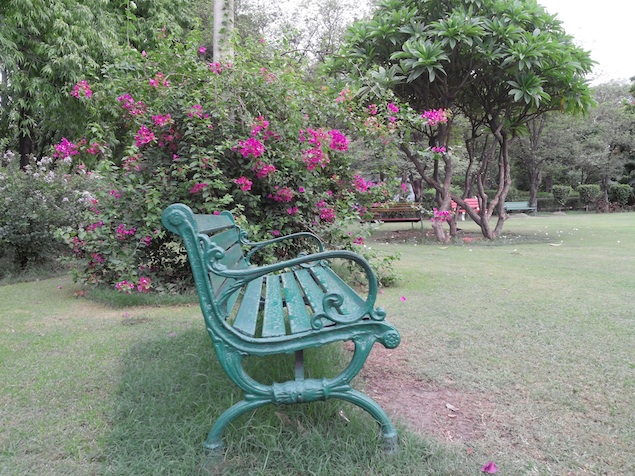 The app offers settings for voice activated shutter (take pictures with voice commands like 'cheese', 'kimchi', 'LG', 'Smile' and 'Whisky'), Focus, Zoom, brightness, image size, scene modes, ISO, white balance, colour effects, timer, geotagging, shutter sound, storage.
The app offers settings for voice activated shutter (take pictures with voice commands like 'cheese', 'kimchi', 'LG', 'Smile' and 'Whisky'), Focus, Zoom, brightness, image size, scene modes, ISO, white balance, colour effects, timer, geotagging, shutter sound, storage.
The Time catch mode starts capturing shots even before you hit the shutter and offers the five best ones, in case you're afraid you'll miss some action. Similarly, the Burst photo mode takes up to 20 pictures in quick succession when you want to capture action. The Intelligent auto mode, which we usually see in Sony's phones, adjusts settings based on the ambient light conditions to enable the best shot.
 In addition to the normal Panorama mode, the phone also adds a VR Panorama (VR stands for virtual reality). This mode is also known as Photosphere and is included in some other Android phones as well. It essentially stitches together different photos to create an almost 3D like view of the surroundings.
In addition to the normal Panorama mode, the phone also adds a VR Panorama (VR stands for virtual reality). This mode is also known as Photosphere and is included in some other Android phones as well. It essentially stitches together different photos to create an almost 3D like view of the surroundings.
The camera app also offers a shortcut to the gallery. It offers 8X zoom, which can be controlled by pinching in and out. The volume buttons also double up as shutter keys when you're in the app, although there is a virtual shutter key as well.
Coming to the quality of images shot with the phone, we observed that images taken outdoors during daylight came out well except that colours were a little over-saturated, and at times white balance was skewed towards lighter shades. If you zoom in photos to their actual size, you'll also see some noise and missing details. Other than that, we found the quality of the photos taken in sufficient light to be satisfactory.
Photos taken indoors in soft light also looked good.
However, the phone had a hard time capturing images in low light even with night mode on if you don't use the LED flash.
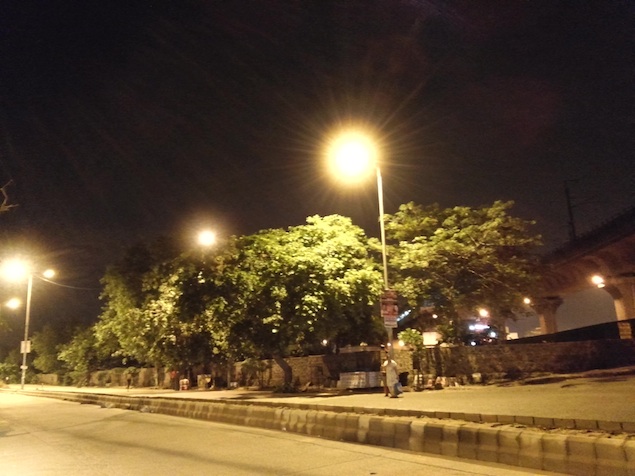 The phone's rear camera also takes good quality videos, and the anti-shaking feature works as promised, unless you shake the phone vigorously. The video recording mode also offers the ability to pause recordings.
The phone's rear camera also takes good quality videos, and the anti-shaking feature works as promised, unless you shake the phone vigorously. The video recording mode also offers the ability to pause recordings.
The Optimus G Pro features a 2.1-megapixel front facing camera that can be used for self clicks and for video chats. We found videos captured indoors through this camera were a bit grainy.
Performance/Battery Life
The LG Optimus G Pro is powered by a 1.7GHz Qualcomm Snapdragon 600 quad-core processor with 2GB RAM onboard, and an Adreno 320 chip (400 MHz) for processing graphics. There is 16GB of internal storage, out of which 10.5GB is available to the user. The phone also offers a microSD card slot for expanding storage up to 64GB.
With Android 4.1.2 Jelly Bean, the overall experience of navigation through the interface was extremely impressive, thanks to Project Butter and all the power under the hood. We did not experience any lag at all while launching apps, scrolling web pages or switching between apps. At times we did experience some stutter while unlocking the screen but that's more likely to be due to all the fancy interface effects LG has added to the UI layer.
Gaming experience was pretty good with games like Temple Run 2, Subway Surfers and Asphalt 7 running without any hiccups.
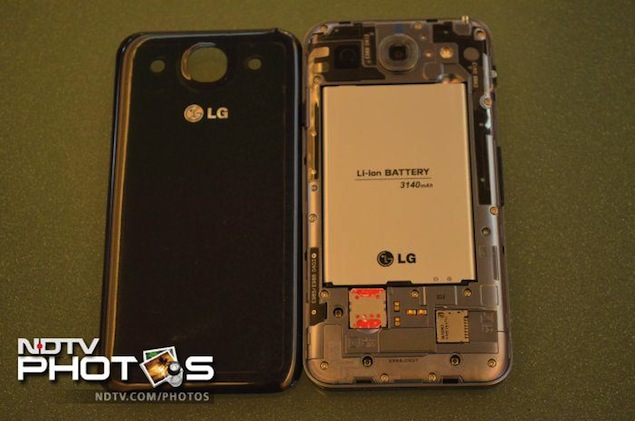 We were able to run all video formats including AVI and MOV through the native video player, though we experienced some issues with audio while playing an MKV format video. This was easily fixed by downloading a third-party video player. The phone plays full-HD videos without a hitch. The speaker on the phone delivers good quality sound at high volume levels but sound gets muffled when the phone lies on its back as the speaker is located on that side. The phone also supports Dolby audio when you plug-in the headphones, which offers a much richer sound.
We were able to run all video formats including AVI and MOV through the native video player, though we experienced some issues with audio while playing an MKV format video. This was easily fixed by downloading a third-party video player. The phone plays full-HD videos without a hitch. The speaker on the phone delivers good quality sound at high volume levels but sound gets muffled when the phone lies on its back as the speaker is located on that side. The phone also supports Dolby audio when you plug-in the headphones, which offers a much richer sound.
Unfortunately, the phone doesn't include FM radio functionality, similar to the Samsung Galaxy S4.
The Optimus G Pro offers Chrome in addition to the default browser. The default browser does not feature Adobe flash for viewing Flash content.
Call quality was good and we were able to get cellular signals even in low signal areas.
The phone comes with a 3140mAh battery, and in our usage, it lasted us a full day with medium usage, including 1-1.5 hours of phone calls, two e-mail accounts with push notifications, playing some music, Twitter notifications and WhatsApp chats.
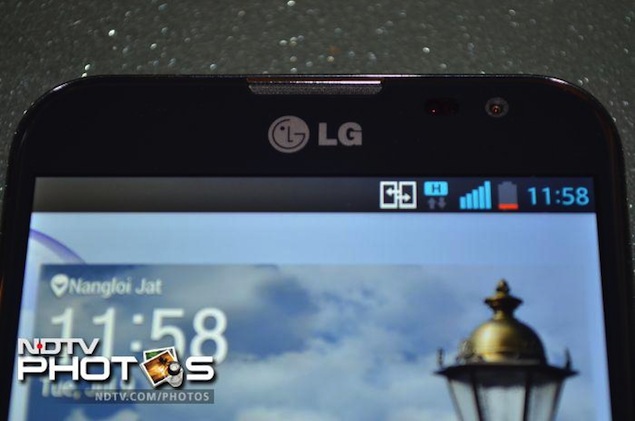 It's worth pointing out that we had turned off Wi-Fi and auto-brightness, and the phone was hooked to a 3G network with the screen brightness at the highest level. Altering these settings might help in running the phone for a longer duration, depending on your usage pattern. The phone also offers a Power Saver mode to optimise processor control to (theoretically) extend battery life.
It's worth pointing out that we had turned off Wi-Fi and auto-brightness, and the phone was hooked to a 3G network with the screen brightness at the highest level. Altering these settings might help in running the phone for a longer duration, depending on your usage pattern. The phone also offers a Power Saver mode to optimise processor control to (theoretically) extend battery life.
The phone also includes NFC capabilities, and we were able to transfer and receive files through Android Beam, which combines Bluetooth and NFC for sharing data. The phone also allows you to transfer files to other devices through Wi-Fi without being on the same Wi-Fi network.
Verdict
The LG Optimus G Pro is one of the best big screen phones available at this point in time. Leaving minor niggles, the phone offers a combination of good build, great software features and high-end hardware under the hood. However, at a price of Rs. 42,500 it faces tough competition from flagships like the Samsung Galaxy S4 and the HTC One. The only visible advantage that it offers over them is the bigger screen size.
If you're looking for a premium full-HD screen smartphone and don't want to wait for the next Galaxy Note (which is likely still more than a month away), we have no qualms in recommending this phone. If screen size is not a major consideration, you can look at the HTC One, Samsung Galaxy S4 and the iPhone 5.
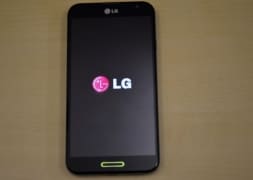
LG Optimus G Pro
Price: Rs. 42,500
Pros
Cons
Ratings (Out of 5)
While there are a number of phones that feature 5.5-inch or plus screens, the Optimus G Pro is among the first to feature a full-HD display. We try to find out if the phone meets all the expectations.
Build/ Design
With a 5.5-inch screen, the LG Optimus G Pro enters the phablet territory. However, when compared to a phone like the Samsung Galaxy Note II, it looks and feels more like a big smartphone, predominantly due to its less wider frame. Still, it's not a phone that would fit comfortably in your pocket. The phone is available in White and Black colour variants and we received the Black one as our review unit.
The front of the phone, made of glass, is mainly dominated by its 5.5-inch HD display. The bezel on the sides of the screen is extremely narrow, though if you notice carefully it still has a small black border surrounding it. The front glass doesn't meet the edges directly but curves and bevels before it reaches there.
There's a physical Home button and two capacitive touch buttons for Back and Menu functions just below the display. The Home button does't protrude out much, unlike Samsung's Galaxy S4 and Note II phones, and is almost flush with the phone. We had a hard time using the button as it's too small in height. It does light up in different colours to alert you whenever there's a notification, though.
 The 2.1-megapixel front facing camera and the sensor array sit a hove the display along with an earpiece grill.
The 2.1-megapixel front facing camera and the sensor array sit a hove the display along with an earpiece grill.The Power/ Screen-lock button is located at the right hand side of the phone, while a customisable 'Quick' key and the Volume rocker key are placed at the left hand side. We found the placement of the keys a bit awkward. For a phone this big, we wish the Power button could have been placed a little lower. Also, we ended up pressing the Quick shortcut button instead of the Volume rocker on several occasions.
The 3.5mm headset jack, Infrared Blaster and a secondary microphone sit at the top. The Micro-USB port and the microphone are located at the bottom.
An aluminium frame runs through the phone separating the back and front panels. The frame is visible as a thin line at the left and right sides, but widens at the top and bottom.
Unlike the LG Optimus G, the Optimus G Pro has a removable back panel which covers the back of the phone and is not boxy, but curved along the edges. Made of plastic, it can be easily removed through a small gap at the right side of the phone. The back has a glossy finish but features a glass weave checkered pattern similar to the one seen in the Nexus 4. However, the cover is prone to smudges and is a little slippery and doesn't provide a good grip.
The 13-megapixel camera lens, the LED flash and a tiny round speaker outlet are located towards the upper part of the back. The lens is surrounded by a raised, almost circular, enclosure which is also visible.
 Removing the back cover, you'd see the battery compartment, with the Micro-SIM and microSD card slots located just below it. While you can replace the microSD card on the fly, you'll need to remove the battery if you want to insert or remove the Micro-SIM.
Removing the back cover, you'd see the battery compartment, with the Micro-SIM and microSD card slots located just below it. While you can replace the microSD card on the fly, you'll need to remove the battery if you want to insert or remove the Micro-SIM.Overall, the phone feels solid without giving an impression of being bulky but we wish it could offer a better grip, especially when it's as big as it is.
Display
The LG Optimus G Pro features a 5.5-inch IPS Plus LCD screen with a resolution of 1080x1920 pixels. It is one of the few full-HD 5.5-inch phones available in the market (the other one being Lenovo K900), at this point in time. It comes with Corning 's Gorilla Glass 2 protection making it resistant to scratches.
 The Optimus G pro's screen looks gorgeous with text and images looking crisp and sharp. Colours look vibrant and brightness was optimum. Viewing angles were also good, though we found the screen to be pretty reflective especially when used outdoors in bright sunlight. Having said that, we didn't experience problems reading text under sunlight.
The Optimus G pro's screen looks gorgeous with text and images looking crisp and sharp. Colours look vibrant and brightness was optimum. Viewing angles were also good, though we found the screen to be pretty reflective especially when used outdoors in bright sunlight. Having said that, we didn't experience problems reading text under sunlight.Since the phone's screen is large, the pixel density is a little less compared to phones like the HTC One or the Samsung Galaxy S4, even though the Optimus G Pro has a full-HD display. This means there are less pixels per inch but you are unlikely to notice the difference.
Software/ User Interface
The LG Optimus G Pro runs Android 4.1.2 Jelly Bean, which is a disappointment as even some budget phones are now shipping with Android 4.2. LG has added its own Optimus UI layer on top, majorly changing the look and feel of the interface and enabling users to customise the phone according to their liking.
LG also adds several tweaks including Smart Screen that keeps the screen on if the phone detects the user's eyes looking at it - a feature we first saw in the Samsung Galaxy S III. It also adds Smart Video, automatically pausing videos when you look away.
 LG also allows users to choose the phone's default font and font size, change how long the capacitive keys backlight stays on, choose the LED light on the Home button to glow with different alerts and correct the aspect ratio of downloaded apps.
LG also allows users to choose the phone's default font and font size, change how long the capacitive keys backlight stays on, choose the LED light on the Home button to glow with different alerts and correct the aspect ratio of downloaded apps.You can select from 4 different visual themes, each with a different icon set, home screen wallpaper and app drawer background. You can have up to 7 screens that can be populated with widgets and app shortcuts. LG even allows you to choose between various animation effects when you swipe from one home screen to another or when you unlock the phone.
We're glad that LG has placed the Back button on the left side in line with the Nexus phones. The Home button doubles up as the task switcher on long press. The contextual Menu button offers various settings when pressed in the home screen mode.
 LG has also skinned the notification tray including toggles for various settings including for sound, data, NFC, Quick remote, Bluetooth, Wi-Fi, and Hotspot among others. It also features shortcuts for invoking QSlide apps, and a control for changing screen brightness.
LG has also skinned the notification tray including toggles for various settings including for sound, data, NFC, Quick remote, Bluetooth, Wi-Fi, and Hotspot among others. It also features shortcuts for invoking QSlide apps, and a control for changing screen brightness.As we mentioned, the phone comes with a 5.5-inch display, and LG has included some additional features to make use of the screen real estate. There are special apps that LG likes to call QSlide apps. These include a web browser, Memo pad, Calendar, Calculator and a Video player. Users can run two of these QSlide apps simultaneously and there's a slider that allows you to focus on one of them. This is similar to what Samsung introduced with some of its devices including the Galaxy Note II.
 LG also offers a QuickMemo app that lets users scribble notes on a blank page or on top of a screen shot. The app also has an overlay mode allowing you to take notes while running another app. We're not sure if people with big hands will find it useful as LG doesn't offer a Stylus with the phone.
LG also offers a QuickMemo app that lets users scribble notes on a blank page or on top of a screen shot. The app also has an overlay mode allowing you to take notes while running another app. We're not sure if people with big hands will find it useful as LG doesn't offer a Stylus with the phone.The phone includes additional ones for Backup, File Manager, File sharing, a Dictionary, a Memo app, a Notebook app, Polaris Office 4, a Quick Translator app, LG's service related apps, LG's own app store (SmartWorld), a Task Manager, and apps for video editing. The phone also allows streaming content to other devices via the DLNA protocol in addition to offering wireless screen mirroring via Miracast to compatible devices.
LG has customised nearly all stock-apps including the Gallery and Music apps, adding more functionality in addition to just bringing eye candy. Even the system settings menus have been skinned and are pleasant to look at.

The home screen also features a landscape mode, and some of the apps, including LG's email app make use of it by offering a preview pane for emails in that mode.
The Music player app, offers additional functionality of giving you access to your music library within the Now Playing screen in landscape mode. It can also display lyrics if embedded in the track and look for the video of the currently playing song on YouTube with the press of a button. It also offers Dolby sound enhancements when headphones are connected to the phone.
Similarly, the Video Player offers a drawer on the right side for browsing videos while playing one. It also allows you to change the brightness by just swiping across the screen vertically, and scrub through it by swiping horizontally. The Video player app can run simultaneously with other apps similar to Samsung's pop-up play feature. The video player also comes with its own QSlide app. Pinch to zoom even works while playing videos to see more details.
 The LG Optimus G Pro also offers a Quick Remote app to be used in conjunction with the phone's Infrared Blaster. It allows the phone to act as a universal remote to control audio, video and home appliances. It even offers remote controls for Indian satellite TV providers such as Tata Sky and Dish TV. We were able to easily configure the app and use the phone as our remote. Interestingly, the app can also be used without unlocking the phone's home screen by long pressing the Home button. It can also be used through a quick shortcut in the notifications panel through a dedicated toggle.
The LG Optimus G Pro also offers a Quick Remote app to be used in conjunction with the phone's Infrared Blaster. It allows the phone to act as a universal remote to control audio, video and home appliances. It even offers remote controls for Indian satellite TV providers such as Tata Sky and Dish TV. We were able to easily configure the app and use the phone as our remote. Interestingly, the app can also be used without unlocking the phone's home screen by long pressing the Home button. It can also be used through a quick shortcut in the notifications panel through a dedicated toggle.LG has also included software features to enable one hand operation. You can set the phone's default keyboard and keypad to be displayed towards the right or left sides.
In addition to all of these, the phone brings standard Jelly Bean functionality. Overall, LG has tried to make the phone as different from stock Android, as possible. While that may delight some, 'stock-Android' fans will be far from impressed.
Camera
The LG Optimus G Pro sports a 13-megapixel rear camera and a 1.9-megapixel front facing camera. We expected it to be a great shooter given the phone's price and high end specifications, but does it deliver?
For starters, the phone features LG's own Camera app which is a bit similar to the app that comes with the LG Optimus G. The app includes a customisable quick menu on one of the sides, which features controls for switching between the front and rear cameras, enabling the Intelligent Auto mode, turning on the Time Catch shot mode, switching between Normal, HDR, Panorama, VR Panorama, Burst shot, Beauty shot and Dual camera photo modes and for accessing the camera settings. These buttons can however be customised by selecting any of the other buttons available in the 'Edit quick menu' option when you tap the Settings button.
 The app offers settings for voice activated shutter (take pictures with voice commands like 'cheese', 'kimchi', 'LG', 'Smile' and 'Whisky'), Focus, Zoom, brightness, image size, scene modes, ISO, white balance, colour effects, timer, geotagging, shutter sound, storage.
The app offers settings for voice activated shutter (take pictures with voice commands like 'cheese', 'kimchi', 'LG', 'Smile' and 'Whisky'), Focus, Zoom, brightness, image size, scene modes, ISO, white balance, colour effects, timer, geotagging, shutter sound, storage.The Time catch mode starts capturing shots even before you hit the shutter and offers the five best ones, in case you're afraid you'll miss some action. Similarly, the Burst photo mode takes up to 20 pictures in quick succession when you want to capture action. The Intelligent auto mode, which we usually see in Sony's phones, adjusts settings based on the ambient light conditions to enable the best shot.
 In addition to the normal Panorama mode, the phone also adds a VR Panorama (VR stands for virtual reality). This mode is also known as Photosphere and is included in some other Android phones as well. It essentially stitches together different photos to create an almost 3D like view of the surroundings.
In addition to the normal Panorama mode, the phone also adds a VR Panorama (VR stands for virtual reality). This mode is also known as Photosphere and is included in some other Android phones as well. It essentially stitches together different photos to create an almost 3D like view of the surroundings.The camera app also offers a shortcut to the gallery. It offers 8X zoom, which can be controlled by pinching in and out. The volume buttons also double up as shutter keys when you're in the app, although there is a virtual shutter key as well.
Coming to the quality of images shot with the phone, we observed that images taken outdoors during daylight came out well except that colours were a little over-saturated, and at times white balance was skewed towards lighter shades. If you zoom in photos to their actual size, you'll also see some noise and missing details. Other than that, we found the quality of the photos taken in sufficient light to be satisfactory.
Photos taken indoors in soft light also looked good.
However, the phone had a hard time capturing images in low light even with night mode on if you don't use the LED flash.
 The phone's rear camera also takes good quality videos, and the anti-shaking feature works as promised, unless you shake the phone vigorously. The video recording mode also offers the ability to pause recordings.
The phone's rear camera also takes good quality videos, and the anti-shaking feature works as promised, unless you shake the phone vigorously. The video recording mode also offers the ability to pause recordings.The Optimus G Pro features a 2.1-megapixel front facing camera that can be used for self clicks and for video chats. We found videos captured indoors through this camera were a bit grainy.
Performance/Battery Life
The LG Optimus G Pro is powered by a 1.7GHz Qualcomm Snapdragon 600 quad-core processor with 2GB RAM onboard, and an Adreno 320 chip (400 MHz) for processing graphics. There is 16GB of internal storage, out of which 10.5GB is available to the user. The phone also offers a microSD card slot for expanding storage up to 64GB.
With Android 4.1.2 Jelly Bean, the overall experience of navigation through the interface was extremely impressive, thanks to Project Butter and all the power under the hood. We did not experience any lag at all while launching apps, scrolling web pages or switching between apps. At times we did experience some stutter while unlocking the screen but that's more likely to be due to all the fancy interface effects LG has added to the UI layer.
Gaming experience was pretty good with games like Temple Run 2, Subway Surfers and Asphalt 7 running without any hiccups.
 We were able to run all video formats including AVI and MOV through the native video player, though we experienced some issues with audio while playing an MKV format video. This was easily fixed by downloading a third-party video player. The phone plays full-HD videos without a hitch. The speaker on the phone delivers good quality sound at high volume levels but sound gets muffled when the phone lies on its back as the speaker is located on that side. The phone also supports Dolby audio when you plug-in the headphones, which offers a much richer sound.
We were able to run all video formats including AVI and MOV through the native video player, though we experienced some issues with audio while playing an MKV format video. This was easily fixed by downloading a third-party video player. The phone plays full-HD videos without a hitch. The speaker on the phone delivers good quality sound at high volume levels but sound gets muffled when the phone lies on its back as the speaker is located on that side. The phone also supports Dolby audio when you plug-in the headphones, which offers a much richer sound. Unfortunately, the phone doesn't include FM radio functionality, similar to the Samsung Galaxy S4.
The Optimus G Pro offers Chrome in addition to the default browser. The default browser does not feature Adobe flash for viewing Flash content.
Call quality was good and we were able to get cellular signals even in low signal areas.
The phone comes with a 3140mAh battery, and in our usage, it lasted us a full day with medium usage, including 1-1.5 hours of phone calls, two e-mail accounts with push notifications, playing some music, Twitter notifications and WhatsApp chats.
 It's worth pointing out that we had turned off Wi-Fi and auto-brightness, and the phone was hooked to a 3G network with the screen brightness at the highest level. Altering these settings might help in running the phone for a longer duration, depending on your usage pattern. The phone also offers a Power Saver mode to optimise processor control to (theoretically) extend battery life.
It's worth pointing out that we had turned off Wi-Fi and auto-brightness, and the phone was hooked to a 3G network with the screen brightness at the highest level. Altering these settings might help in running the phone for a longer duration, depending on your usage pattern. The phone also offers a Power Saver mode to optimise processor control to (theoretically) extend battery life.The phone also includes NFC capabilities, and we were able to transfer and receive files through Android Beam, which combines Bluetooth and NFC for sharing data. The phone also allows you to transfer files to other devices through Wi-Fi without being on the same Wi-Fi network.
Verdict
The LG Optimus G Pro is one of the best big screen phones available at this point in time. Leaving minor niggles, the phone offers a combination of good build, great software features and high-end hardware under the hood. However, at a price of Rs. 42,500 it faces tough competition from flagships like the Samsung Galaxy S4 and the HTC One. The only visible advantage that it offers over them is the bigger screen size.
If you're looking for a premium full-HD screen smartphone and don't want to wait for the next Galaxy Note (which is likely still more than a month away), we have no qualms in recommending this phone. If screen size is not a major consideration, you can look at the HTC One, Samsung Galaxy S4 and the iPhone 5.

LG Optimus G Pro
Price: Rs. 42,500
Pros
- Good build quality
- Good performance
- Decent battery back-up
Cons
- Camera could have been better
- Price
Ratings (Out of 5)
- Design: 3.5
- Display: 4
- Performance: 4
- Software: 3.5
- Battery Life: 3.5
- Value for Money: 3
- Camera: 3
- Overall: 3.5

0 comments:
Post a Comment